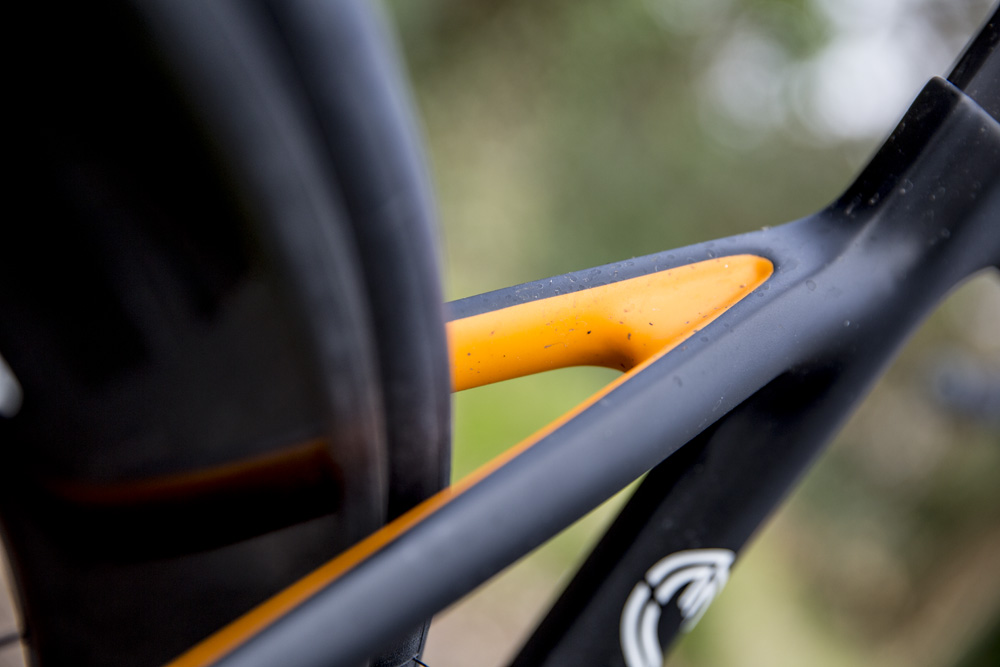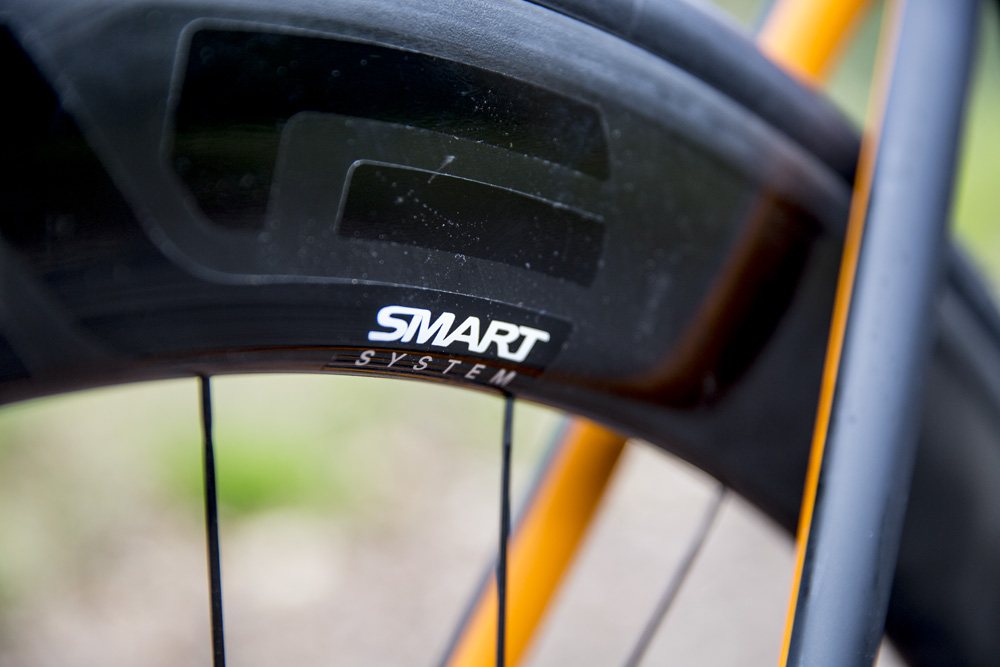Parlee ESX-R Custom review
For those unfamiliar with the Massachusetts-based brand, Parlee has a reputation for producing superb quality carbon-fibre bikes with a large emphasis on customisation. New for 2015 is the ESX-R, which is a slightly more affordable version of Parlee's ESX (£3.999). We put it through its paces to see how good it is.

If you are lucky enough to be in the market for a Parlee, the ESX-R will not disappoint. For £700 more, you could buy the 100g lighter ESX, but considering how good the ESX-R is, I’m unsure why you would. Having ridden both, I could not tell the difference, and the £700 saved would buy you a stunning custom paintjob. Obviously I am biased, but I really like the way this machine looks. It is stealthy with the flashes of orange adding an element of Lamborghini excitement. While testing this, I was simultaneously testing the Cervélo S5. So good is the Parlee ESX-R that having to ride the top-spec Cervélo S5 felt like a chore. First-world problems…
-
+
Incredible custom paintjobs available
-
+
Sublime ride quality
-
+
Superbike excitement
-
+
Looks
-
+
Lifetime frame warranty
-
-
High front end geometry
-
-
Paint mark on the fork from catching the frame
-
-
Saddle clamp can slip. Allen bolts are hard to access
-
-
Aero seat post can stick.
You can trust Cycling Weekly.
When Parlee approached us with the offer of supplying us with a custom ESX-R to test and review, it was quite frankly too good an opportunity to turn down. The first part of the process was a trip to Bespoke in Farringdon, where their fitter Chris used a Retül jig to determine the exact frame size I would require and how to best set it up.

Following my visit to Bespoke, we chose the components and custom paint job. The finish we chose is matte black and white, with Lamborghini orange on the inner stays and forks. Considering this is a super bike, I wanted to add some super car style colour. To experiment with your own custom paint jobs, here is a link to the Parlee configurator.
In order to avoid parts being damaged, Parlee ships its bikes direct from the USA unassembled. When the bike arrived we built it up from scratch. Below is a time lapse video of the Parlee ESX-R being built by our mechanic at Cycling Weekly.
Frame

I went for a fairly simple matt black and white with Lamborghini orange on the inner stays and forks. Considering this is a superbike, I wanted to add a little supercar colour.
The Parlee ESX-R frame is striking and features unusual Recurve tube cross-sections that Parlee claims were chosen in order to maximise aerodynamics without sacrificing comfort or stiffness.
The pursuit of aerodynamic tube shapes can quite often result in a harsh ride and excess weight. Company founder Bob Parlee has a background in designing and fabricating boats, which, according to Parlee, was of great use in the design of the ESX: “His experience creating shapes and sections that move through fluid with optimal efficiency helped inform the design process of Recurve tubing.”
Parlee claims that, with its unique ‘fluted tail’ shape, “Recurve delivers the ideal blend of low drag and high torsional stiffness — along with road-smoothing comfort so often lacking in aero bikes.”
The latest race content, interviews, features, reviews and expert buying guides, direct to your inbox!
I weighed the frame and fork and can report that their respective weights are 1,060g and 370g, which is light for an aero road bike.
Geometry
Parlee offers its Z-Zero model in full custom geometry, but not on the ESX and ESX-R . Instead they offer an extensive range of sizes to go with custom specification and paint job. The sizes range from small to extra large, with each individual size offering three different stack and reach combinations.
This huge choice means that a relaxed geometry is possible, which is in contrast to the aggressive stock geometry on many aero frames, such as the Canyon Aeroad CF SLX. Based upon the fit data from our Retül session at Bespoke, Parlee suggested a size ML with a short stack, to be used in conjunction with a 120mm stem.
Geometry is compact/sloping similar to that found on the Giant TCR. For those interested in specific numbers, my drop is 102mm and the tip of the saddle to bar tops is 575mm.

The Parlee ESX-R frame is striking, and can be considered fairly Marmite. It features unusual 'Recurve' tube cross sections that Parlee claim were chosen in order to maximise aerodynamics, without sacrificing comfort or stiffness. A common association with aero road bikes, is that the pursuit of aerodynamic tube shapes often results in a harsh ride.
Bob Parlee has a background in designing and fabricating boats, which according to Parlee, was of great use in the design of the ESX. "His experience creating shapes and sections that move through fluid with optimal efficiency helped inform the design process of Recurve tubing."
Parlee claims that with its unique 'fluted tail' shape, "Recurve delivers the ideal blend of low drag and high torsional stiffness—along with road-smoothing comfort that is so often lacking in aero bikes." Needless to say, I can't wait to see how it translates on the road. The pseudo pavé that makes up many a Surrey lane being an ideal proving ground.

Viewed head on the Parlee ESX-R is clearly an aerodynamic machine, with its bladed fork and narrow tube sections. Also fitted, is a K-Edge Garmin mount and Michelin Pro 4 Race tyres.

The down tube features an iconic and distinctive fin shape, that protrudes from the leading edge. I was initially unsure about this shape, but its profile has really grown on me. Maybe this is a case of if an object is highly functional and performs very well, the visual appreciation of the form will follow.

Specification
Not wanting to compromise the top-end frame, I specified Shimano Dura Ace Di2 for this bike.
>>> Complete buyers guide to road bike groupsets
The chainset is a mid-compact 52-36 matched to an 11-28t casette, as I feel this is the best all-round option for most scenarios.

The brakes on the ESX and ESX-R are direct mount. I am a huge fan of the increased power and superior modulation offered by direct mount brakes. It is a big advantage and selling point found on other bikes like the Canyon Aeroad CF SLX and Merida Reacto.

One minor disadvantage of Shimano direct mount brakes to be aware of is that the rear calliper can sometimes prevent the fitting of a Stages power meter.
Parlee informs me that this is not an issue with the EE Cycleworks brakes fitted on our test bike. For those not familiar with EE brakes, they are super light, weighing less than 200g per set, and super functional with a very industrial aesthetic (our pair weighed only 154g!).

In the same way a Ferrari would look ridiculous with 16 inch rims, aero bikes just don't look right unless they have aero wheels. Considering this I specced the ESX-R with Enve 6.7 carbon clinchers and Chris King hubs.
SES stands for Smart Enve Systems and the number corresponds to the rim depth. The 6.7 indicates that the front wheel is 60 mm deep and the rear one is 70 mm deep. The 6.7 clinchers are not the lightest wheels available to humanity, hitting our scales at 710g for the front and 930g for the rear, but there is no doubting their practicality aerodynamics and visual appeal.

Some sounds seem to really appeal to the human psyche, for me, the resonating roar of a Spitfire Rolls Royce Merlin engine is something very special indeed. While maybe not quite in the same league, there is no doubting the ability of the Chris King free hub's bee swarm like buzz to put a smile on the face of anyone riding one. Even when building this bike, it was clear that these hubs and bearings love to roll.

Possessing quite narrow sit bones and position that is quite aggressive, the saddle of choice is a Fizik Arione. The R1 fitted on this bike has carbon rails, hitting the CW scales at a featherweight 149g.

We recently did a bar tape grouptest in the March 19 issue of Cycling Weekly. The deserved winner of this test was Lizard Skins, so I was delighted when the ESX-R came with this bar tape. If you haven't experienced Lizard Skins tape, I highly recommend it – its supple and highly tactile feel is a joy. In addition, it is highly durable.

Bars and stem are from the Italian specialists, 3T. The stem is an aluminium 120mm ARX II team which weighs 138g and the bars are 3T Ergonova Team 42cm carbon, weighing 199g. The Ergonova bars feature a classic and pretty neutral shape.

Riding
In a word: sublime. Having ridden several aero frames on the pseudo pavé that constitutes many a Surrey lane, I have often been shaken to bits, ending long rides feeling the onset of vibration white-finger. Without question, this is the most comfortable aero frame I have ridden.
It really does iron out the road. The plush ride does not hamper performance; you can be serenely cruising around, then ferociously launch up a hill or round a corner, should you want to. The ESX-R’s excitability is thanks in part to a relatively short wheelbase, very stiff bottom bracket and laterally stiff fork.

Handling is assured, but some may prefer a lower front end (the stack is 58cm) on what is roughly a 56cm frame — ideal for those wanting a more relaxed geometry, but if you seek an aggressive position, a negative stem may be required.
Two slight niggles. Firstly the saddle clamp could be a better design. I suffered a couple of slippages during the test period. Secondly the fork has a tendency to catch on the frame just below the head tube. This has caused a slight mark in the paint on either side of the fork, which, considering the price, is unacceptable and something I would want sorted.

Value
If you are after value, you shop at Netto, not Harrods. Despite being prohibitively expensive (somewhere in the region of £10,000 for the build shown), the Parlee ESX-R Custom will not leave the lucky few who can afford it dissatisfied.
The ride is comfortable but direct, handling is poised yet exciting, and the ESX-R is exactly as stiff as it needs to be. We are firmly in superbike territory, but considering how good it is, and that it is £700 cheaper than the ESX, one could argue it is good value.
For more information, head over to Parlee.
Oliver Bridgewood - no, Doctor Oliver Bridgewood - is a PhD Chemist who discovered a love of cycling. He enjoys racing time trials, hill climbs, road races and criteriums. During his time at Cycling Weekly, he worked predominantly within the tech team, also utilising his science background to produce insightful fitness articles, before moving to an entirely video-focused role heading up the Cycling Weekly YouTube channel, where his feature-length documentary 'Project 49' was his crowning glory.